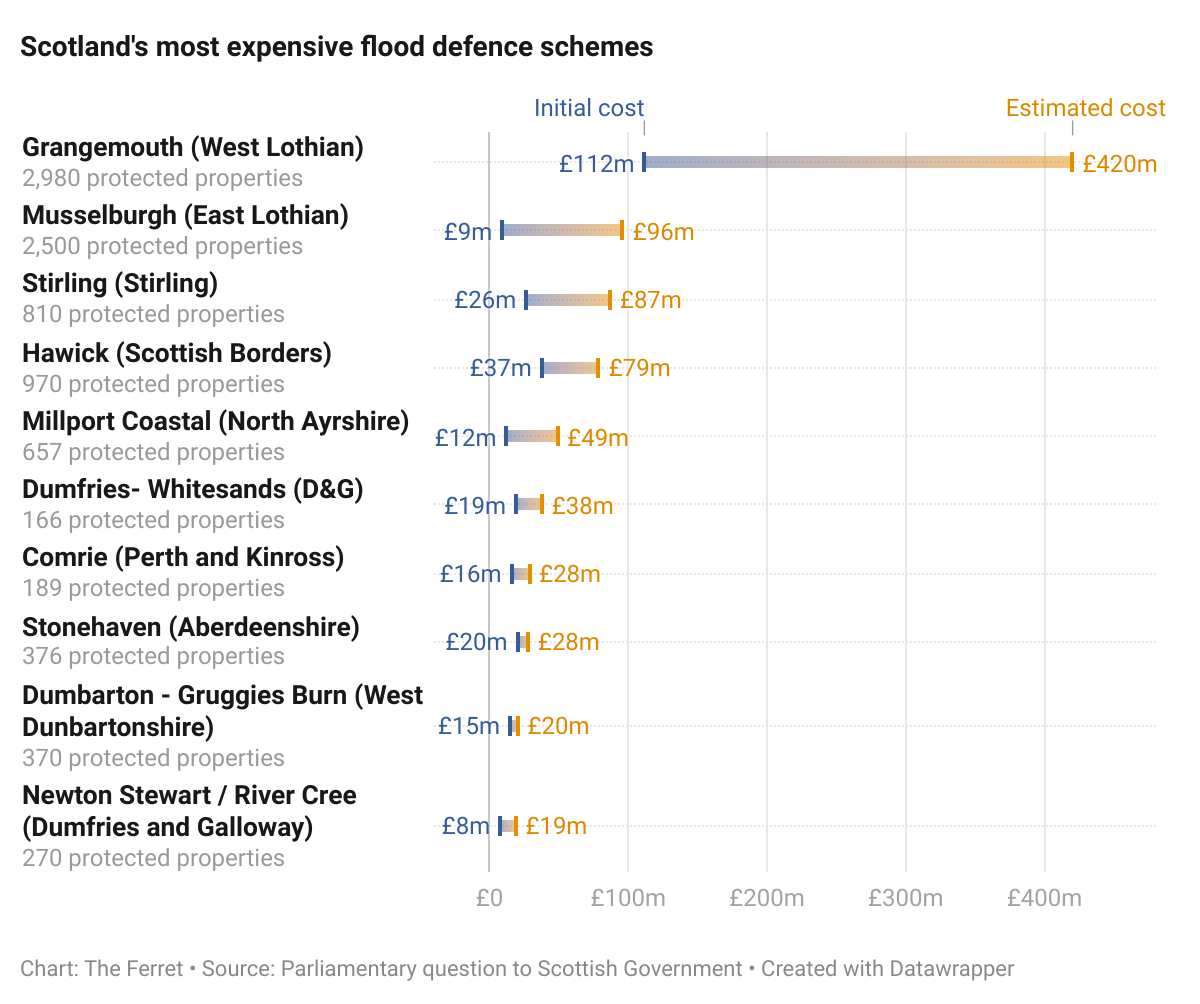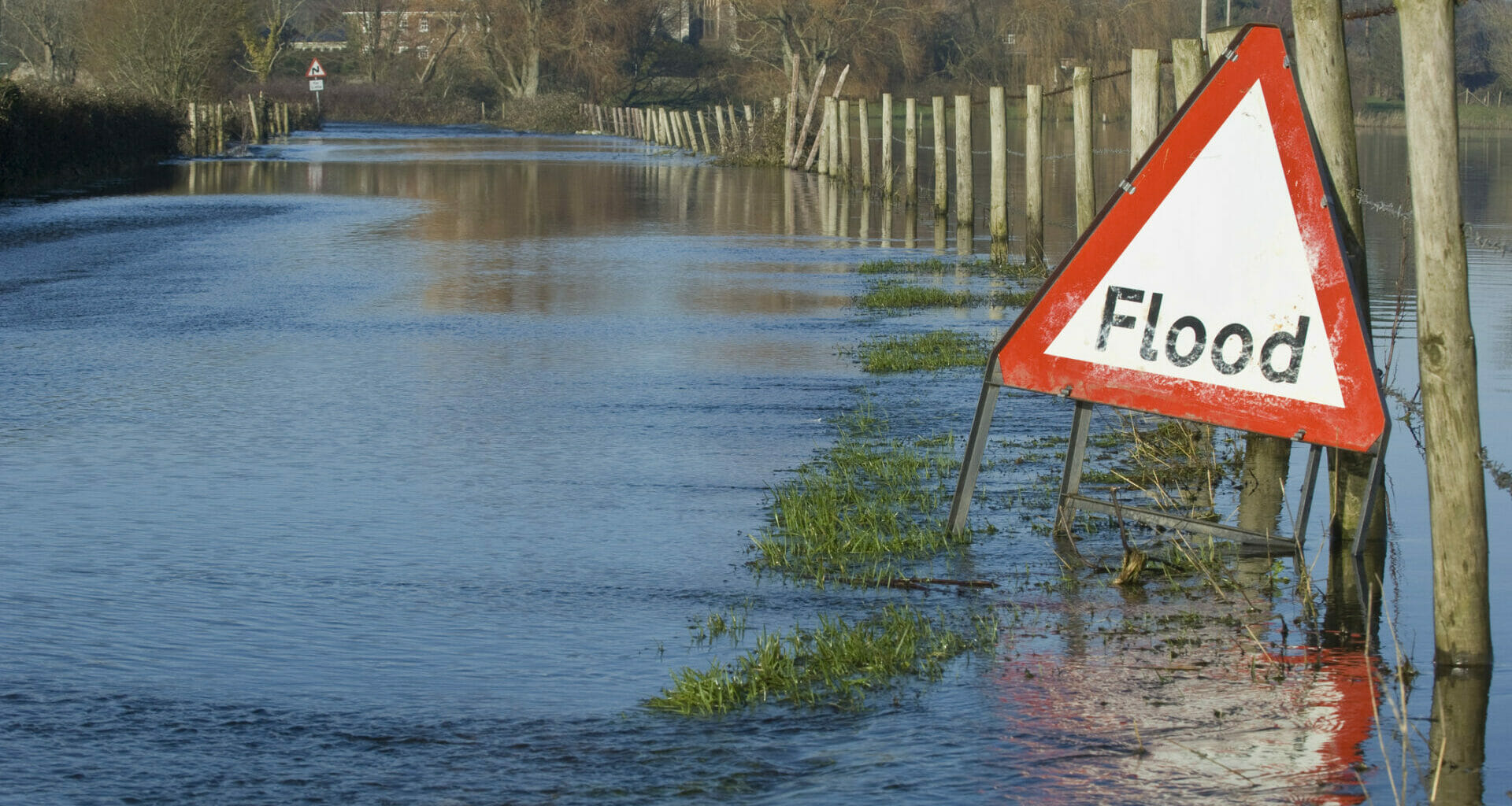Twenty-eight ‘vital’ Scottish flood defence schemes are now expected to cost nearly one billion pounds – three times more than was first estimated in 2016.
Analysis by The Ferret has found that the schemes will cost a combined £985m while providing just under 13,000 properties with protection from flooding.
This means that, across Scotland, the average cost of defending just one property under the schemes will be in excess of £76,000.
The schemes – which are designed by councils but mostly funded by the Scottish Government – are all behind schedule and were due to be delivered by 2021.
Opposition politicians said the “staggering” figures showed the Scottish Government is “casual and incompetent” with taxpayers’ money, and claimed its flood protection plan was “little more than a damp squib”.
The SNP’s coalition partners, the Scottish Greens, argued that nature-based approaches to flooding – like tree planting and the re-meandering of rivers – should be adopted to help reduce costs.
The Scottish Government claimed that the “scope” of many flood schemes had changed during the development phase, causing costs to increase. A spokesperson also blamed “unavoidable inflationary pressures” for the rises and noted that flood schemes are developed and delivered by local councils.
In 2016-17, local authorities forecast that it would cost a combined £337m to build the flood schemes.
The figures were revealed in response to a parliamentary question by the Scottish Liberal Democrat MSP, Liam McArthur.
Costs rising across Scotland
Currently, 284,000 homes and premises around the country are considered to be at risk of flooding from rivers or the sea. It is estimated that floods cause up to £250m worth of damage each year across the country.
Climate change is also expected to increase the severity and frequency of floods, potentially threatening a further 110,000 Scottish properties by 2080.

The 28 schemes were among 42 “priority” flood projects identified by the Scottish Government and Scottish Environment Protection Agency (Sepa) in 2015. All 42 were due to be completed by 2021.
Thirteen flood defence projects have been completed to date, with one, in Greenock, deemed no longer necessary by the local authority. Flood defences for residents of Broughty Ferry, Kirkintilloch and Drumnadrochit were finished last year.
Just six of the 28 outstanding schemes analysed by The Ferret are expected to be completed by the end of 2023. The combined cost of these projects has increased by £77m, or more than 80 per cent, since they were outlined in 2016-17.
Sixteen of the remaining 22 schemes are still under development while another six have been paused.
The biggest total cost hike has come at Grangemouth. The flood scheme there – which is currently on hold but expected to protect important industry and infrastructure – is now projected to cost £420m, nearly four times the £111m estimated in 2016-17.
Schemes in Musselburgh and Arbroath have seen the biggest cost inflation.
Musselburgh’s flood scheme is anticipated to cost more than ten times what it was six years ago, while Arbroath’s will be nine times more expensive.
Each property protected by the Comrie scheme in Perth will cost £150,000, more per property than under any other scheme around Scotland.
The Scottish Government told The Ferret that it and COSLA, the body which represents Scottish councils, are discussing a way forward for the paused schemes as well as new schemes which are due to be constructed before the end of 2028.
Priority schemes receive 80 per cent of their funding from the Scottish Government and the remainder from the local authority where they are constructed.

Natural or manmade?
One mooted way of decreasing the costs of Scottish flood schemes is making greater use of so-called ‘nature-based’ solutions rather than, or alongside, expensive engineered defences like flood walls, dams and embankments.
Nature-based solutions include measures like planting trees, digging ponds, and re-meandering historically straightened rivers, in order to slow down the flow of flood water passing through affected areas.
The Scottish Government and Sepa have already funded a project to assess the impact of restoring natural features as a response to flooding at Eddleston Water, a tributary of the River Tweed in the Borders.
The debate over nature-based and engineered solutions has been particularly fierce in Musselburgh, home to the Scottish flood scheme which has seen the largest percentage increase in cost since 2016.
The Musselburgh scheme was forecast to cost £8.9m six years ago, but is now estimated at £95.9m.
This increase is partly a result of the scheme being updated to include £52m repairs to a nearby sea wall.
But locals have also argued that East Lothian Council and its consultants are pursuing an expensive, engineered approach to the town’s flooding problem.
The SNP’s flood defence plan is little more than a damp squib.
MSP Daniel Johnson, Scottish Labour
One critic is Professor Roger Crofts, the first chief executive of Scottish Natural Heritage – now NatureScot. The independent environmental adviser is also a Musselburgh resident whose home could be at risk of flooding from the River Esk.
He told The Ferret that the “hard engineering” approach taken by the council is one of the reasons for escalating costs.
“This approach fails to grasp that the longer term environmentally sensitive approach to slowing water flow from the catchment down to Musselburgh is best done by mimicking nature,” Crofts said.
“That will be a cheaper, more long term and more environmentally sustainable solution, also achieving other international goals for climate change and biodiversity.”
Crofts believes cost increases have also been caused by what he says is the unnecessary replacement of four bridges in the town and a failure to include coastal defences in the initial 2016-17 estimates.
East Lothian Council said flood protection scheme estimates in 2016/17 were based on estimates for projects not yet designed, adding that "clearly project costs will evolve". A council spokeswoman also pointed out that UK Climate Projections published by the Met Office in 2018 identified a "major increase in projected future flood risk" to the UK.
"In 2016 the Musselburgh Flood Protection Scheme was estimated at £8.9m, based on an initial concept that did not have any design work or public consultation undertaken. This scheme was intended to protect against river flooding from the River Esk only and estimated to protect in the order of 900 properties," the spokeswoman added.
‘Damp squib’
The Scottish Conservatives’ shadow net zero, energy and transport secretary, Liam Kerr, branded the rising costs of flood defence as “staggering” and a “stark example of how casual and incompetent” the Scottish Government is with taxpayer money.
“Despite the biggest UK funding since devolution began, they squander millions on schemes they haven’t checked out – throwing public cash at failed nationalisations, ferries that never arrive, and a string of hopeless court cases, not least their endless pursuit of independence,” Kerr claimed.
“Meanwhile, Scots at real risk from flooding and rising seas don’t get the solutions they deserve.”
Scottish Labour MSP, Daniel Johnson, argued that the need for flood protection is “only going to grow” due to the effects of “climate change and extreme weather”.
Johnson said: “The SNP’s flood defence plan is little more than a damp squib.
“It is vital that we get value for money and best practice when building this infrastructure. The SNP must do more to deliver high-quality flood defences at the right price.”
This approach fails to grasp that the longer term environmentally sensitive approach to slowing water flow from the catchment down to Musselburgh is best done by mimicking nature.
Professor Roger Crofts
Scottish Greens MSP, Mark Ruskell, said it was vital that flood solutions are “developed with communities rather than imposed upon them”.
“With the climate crisis worsening around us, it is vital that we adapt and prepare our communities to mitigate the damage,” Ruskell told The Ferret.
“Whether it is tree planting, re-meandering rivers or other steps, these can be delivered in a way that reduces the cost and extent of conventional built flood defences that are needed.”
A Scottish Government spokesperson said it is consulting on a new approach to flood management which would “increase the use of nature-based solutions and engage a broader range of delivery partners to deliver more diverse flood management actions faster.”
They added: “The responsibility for development and delivery of flood protection schemes rests with individual local authorities, who are best placed to respond to local resilience needs.
“The scope of flood protection schemes can change through the development phase and can impact on costs, which have also been subject to unavoidable inflationary pressures in recent years.
“The Scottish Government is working with COSLA and local authorities to improve the accuracy of cost estimates for flood protection schemes.”
COSLA said it was working with the Scottish Government to address the “overall affordability” of flood schemes.
A spokesperson added: “This is in recognition that costs have increased for reasons including additional construction and energy inflation.”
Other reasons included the effects of Brexit and Covid as well as a shortage of construction materials, they claimed.
Cover image thanks to MikeNicholson1955 / iStock
This Ferret story was also published in the Sunday National. Our partnerships with mainstream media help us reach new audiences and become more sustainable as a media co-op. Join us to read all our stories and tell us what we should investigate next.














